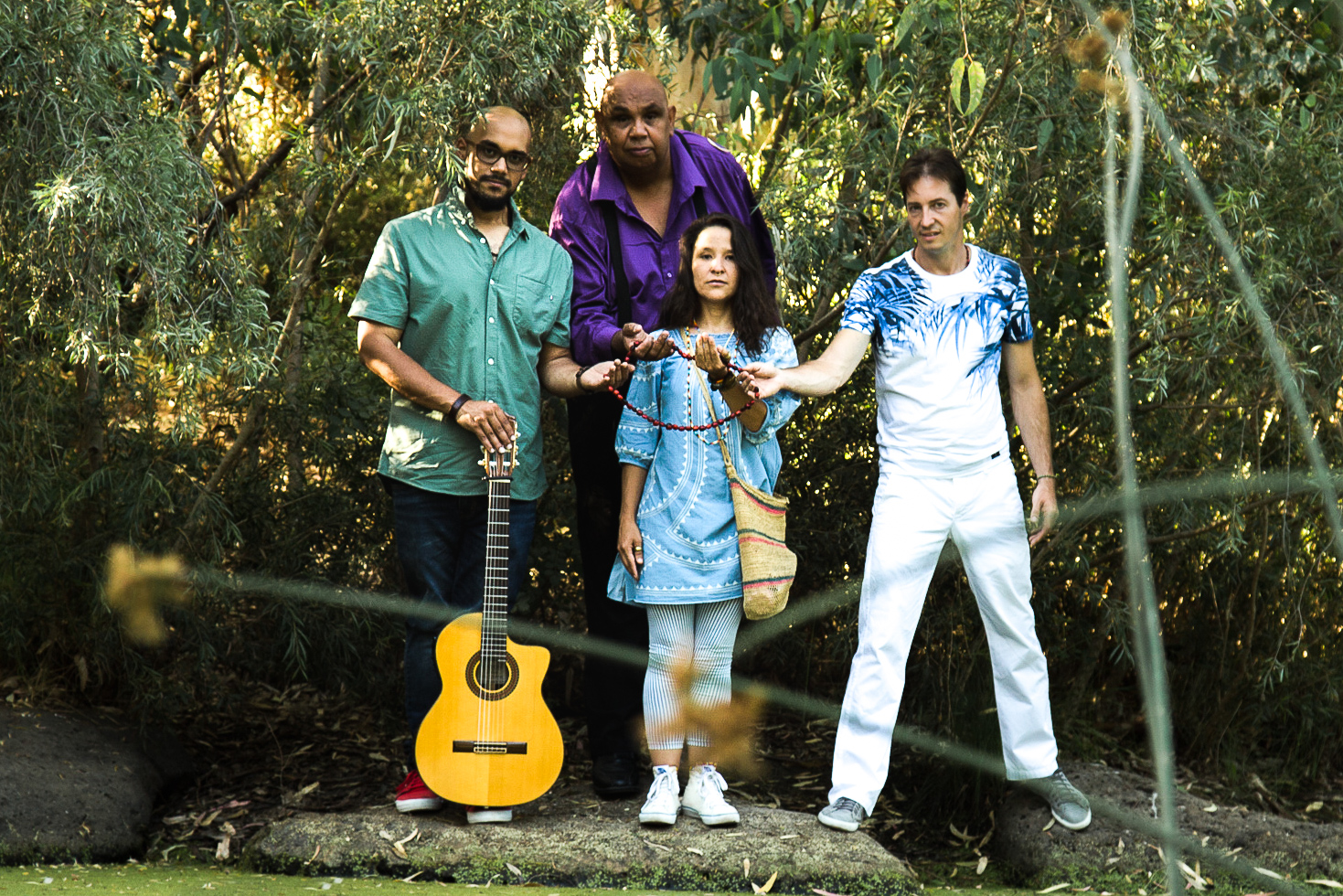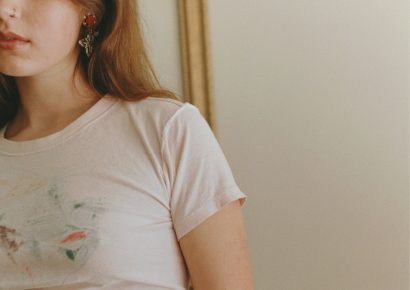Spirit Lines brings together Mutti Mutti man Kutcha Edwards, multiple Latin Grammy winner Daniel Jauregui and percussionist Adrian Hearn. How did you three meet?
KE: I met Daniel at Common Ground behind the Arts Centre Melbourne. I was performing with an arts collective involved with bringing together performers from Bali and Australia, Daniel was there in a role as a videographer. For some reason I asked him “Is that the only thing you do?” He replied “No, I’m actually a guitarist too.” I then asked one of the band members to pass Daniel a guitar. We then went on to play a short impromptu performance together.
I met Adrian at a meeting at Ceres (East Brunswick) where Daniel was also in attendance. We were all meeting with Kathleen Gonzalez for a performance for The Ventana Destival (Frankston). I can’t actually recall when I first met Kathleen.
DJ: After that wonderful and unusual experience with Uncle Kutcha at Common Grounds back in 2017, Jill Morgan (then CEO of Multicultural Arts Victoria) organised for us to have a chat. The first time we had coffee, Uncle asked “so…Daniel, Whats your propose?” I went completely silent. Fast forward almost two years and not only have I found the answer to that question, but I am living by the ripples of it.
Roughly around the same time I stared collaborating with the project Suns Of Mercury, lead by Adrian Hearn. We soon started sharing very similar conversations about our role as artists and our responsibility. I soon found myself having lots of conversations with Adrian and Uncle. It was just matter of time for us to work on a collaboration and that’s what Spirit Lines is, beside sharing our passion for music, Spirit Lines is born from entering the conversation, music is just the medium and facilitator.
AH: Daniel was working with Kutcha in community music workshops and with me in a Suns of Mercury production called I Am Ashé. He introduced Kutcha and Adrian through the Seven Beads project, which joined us as a trio together with dancer Kathleen López and digital projectionist Fabian Cordero in February 2019.
What talents do each of you bring to the collaboration?
KE: I think that the word “collaboration” is the key to what happens when we come together. There is the rhythm of life to which Adrian Hearn keeps, Daniel J Marquez has the amazing capacity to hear and then bind together a kaleidoscope of melodies & rhythms.
DJ: Kutcha is a powerful singer capable of capturing the attention of room with just his presence. When Adrian plays the Bata, times goes still and you are transported into a trans experience. However, I should like to go beyond the music. Ee are entering a conversation about culture, and coexistence in mutual respect. something that is needed in Australian society, and this is our aporte.
AH: Kutcha sings from a deep and proud tradition of Indigenous Australian connection with community, ancestry, and the environment. While Daniel’s roots are planted in Venezuela’s rich folk music, he has toured and recorded with some of Latin America’s most prominent popular music acts. As an initiated batá drummer, Adrian’s English and Brazilian ancestry comes through in compositions that find middle ground between Pink Floyd and Santana.
You are all very different in what you bring to the table. Was it ever difficult to find a common thread between the three of you?
KE: No, we seem to all be on the same page, we all have the common goal to represent our people through song & dance – living culture.
DJ: We come from totally different parts of the world, we have different backgrounds, stories and cultural baggage and yet we share so much. We share a similar vision from three different perspectives that enables us to work in a common ground. I’m just proud to be working alongside men that I respect and admire. We can shine in our similarities and it’s also an opportunity to learn from our differences.
AH: There wasn’t really an expectation among us that this collaboration would work. We know we’re very different in almost every way, but somehow that has become a strength. We’re each pursuing common musical and social goals, which feels meaningful and powerful. It seems we coincide in approaching music as channel of communication between ourselves and a wider spiritual universe. There’s a sense when we meet that something special is surrounding us, and we often spend half of our rehearsal time talking about that.
What are you trying to achieve through Spirit Lines?
KE: Connection.
AH: Spirit Lines is about appreciating the power of dialogue. The fact that different ancestral lines can converge in a spirit of hope suggests that positive change is possible when people talk with each other and listen. We’ve all experienced feelings of hopelessness and irrelevance, but small efforts can inspire others. Spirit Lines is a small step along a pathway to reconciliation between ourselves, the environment, and our ancestors. It’s like dropping a pebble.
DJ: As an immigrant from Venezuela, I come from a place of struggle and despair. However, I believe in the power of music and arts as a transformative tool that can assist for the better of us all. Spirit Lines is a way to enter the conversation and, through music, find a deeper connection. You could say this is the place where our spirits meet.
Spirit Lines also brings to life contemporary dance and video projections. How does this compliment the music side of the project?
KE: Movement – (dance), image – (projection), song – (sound), rhythm – (drums).
DJ: For me, music is the physical manifestation of something bigger. When music is happening inside my head, I can not only listen to it, but smell it, see it and experience it with movement. In one word, it’s alive and it has its own spirit. So Kathleen’s dance and Fabian’s projections are not just a complement for the music, but it’s part of a deeper connection.
AH: Joining together multiple artforms is a great way to collectively explore ideas. Since we met we’ve been experimenting with layers of stimulus that coordinate video projections with dance and live music. We’re aiming for something that goes beyond the sum of its parts: a chorus of the senses that brings our ears, eyes, and spirits into harmony.
How are the dancing and visual projections carried out in a live setting?
KE: We’re trying to encompass all the elements.
AH: For this performance, we are joined by acclaimed contemporary dancer Kathleen González and digital projection specialist Fabian Cordero, who also worked with us on Seven Beads. The projections display scenes of natural beauty in digital collages that look both ancient and futuristic, and Kathy’s movements are a force of nature. Cuidado! (“Watch out” in Spanish).
DJ: It’s an absolute pleasure to have Kathleen Gonzalez and Fabian Cordero joining us for the night. We are going to make use of the Church’s large space for Kathleen to dance around the audience while Fabian’s projections are beamed on the wall of the church. This is going to make it truly special.
What can we expect from your upcoming show at the Church of All Nations?
AH: The performance at the Church of All Nations is a celebration of unity in diversity. Everything about it builds harmony from difference; from the multimedia experience to the musicians themselves. The message is both its form and its content: a crossroads of the Spirit Lines.
KE: Our role is to drop an imaginary pebble in a pond & create a ripple. We can’t determine what the ripple will do, it is up to an audience to determine whether they agree or disagree with what is being presented.
DJ: You can expect music and conversation about society, family, love, land, sovereignty, belonging, identity. You are most welcome to join the conversation where music is the glue.
Spirit Lines will perform at Church of All Nations on Friday August 16. Tickets are available via www.boite.com.au.

